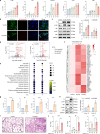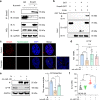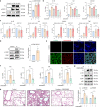SARS-CoV-2 nucleocapsid protein triggers hyperinflammation via protein-protein interaction-mediated intracellular Cl- accumulation in respiratory epithelium
- PMID: 35896532
- PMCID: PMC9328007
- DOI: 10.1038/s41392-022-01048-1
SARS-CoV-2 nucleocapsid protein triggers hyperinflammation via protein-protein interaction-mediated intracellular Cl- accumulation in respiratory epithelium
Abstract
SARS-CoV-2, the culprit pathogen of COVID-19, elicits prominent immune responses and cytokine storms. Intracellular Cl- is a crucial regulator of host defense, whereas the role of Cl- signaling pathway in modulating pulmonary inflammation associated with SARS-CoV-2 infection remains unclear. By using human respiratory epithelial cell lines, primary cultured human airway epithelial cells, and murine models of viral structural protein stimulation and SARS-CoV-2 direct challenge, we demonstrated that SARS-CoV-2 nucleocapsid (N) protein could interact with Smad3, which downregulated cystic fibrosis transmembrane conductance regulator (CFTR) expression via microRNA-145. The intracellular Cl- concentration ([Cl-]i) was raised, resulting in phosphorylation of serum glucocorticoid regulated kinase 1 (SGK1) and robust inflammatory responses. Inhibition or knockout of SGK1 abrogated the N protein-elicited airway inflammation. Moreover, N protein promoted a sustained elevation of [Cl-]i by depleting intracellular cAMP via upregulation of phosphodiesterase 4 (PDE4). Rolipram, a selective PDE4 inhibitor, countered airway inflammation by reducing [Cl-]i. Our findings suggested that Cl- acted as the crucial pathological second messenger mediating the inflammatory responses after SARS-CoV-2 infection. Targeting the Cl- signaling pathway might be a novel therapeutic strategy for COVID-19.
© 2022. The Author(s).
Conflict of interest statement
The authors declare no competing interests.
Figures








Similar articles
-
SARS-CoV-2 envelope protein impairs airway epithelial barrier function and exacerbates airway inflammation via increased intracellular Cl- concentration.Signal Transduct Target Ther. 2024 Mar 25;9(1):74. doi: 10.1038/s41392-024-01753-z. Signal Transduct Target Ther. 2024. PMID: 38528022 Free PMC article.
-
Increased intracellular Cl- concentration promotes ongoing inflammation in airway epithelium.Mucosal Immunol. 2018 Jul;11(4):1149-1157. doi: 10.1038/s41385-018-0013-8. Epub 2018 Mar 15. Mucosal Immunol. 2018. PMID: 29545647
-
Toxoplasma gondii infection triggers ongoing inflammation mediated by increased intracellular Cl- concentration in airway epithelium.J Infect. 2023 Jan;86(1):47-59. doi: 10.1016/j.jinf.2022.10.037. Epub 2022 Nov 2. J Infect. 2023. PMID: 36334726
-
The Mechanistic Links between Insulin and Cystic Fibrosis Transmembrane Conductance Regulator (CFTR) Cl- Channel.Int J Mol Sci. 2017 Aug 14;18(8):1767. doi: 10.3390/ijms18081767. Int J Mol Sci. 2017. PMID: 28805732 Free PMC article. Review.
-
The role of intracellular calcium signals in inflammatory responses of polarised cystic fibrosis human airway epithelia.Drugs R D. 2006;7(1):17-31. doi: 10.2165/00126839-200607010-00002. Drugs R D. 2006. PMID: 16620134 Review.
Cited by
-
A SARS-CoV-2-specific CAR-T-cell model identifies felodipine, fasudil, imatinib, and caspofungin as potential treatments for lethal COVID-19.Cell Mol Immunol. 2023 Apr;20(4):351-364. doi: 10.1038/s41423-023-00985-3. Epub 2023 Mar 2. Cell Mol Immunol. 2023. PMID: 36864189 Free PMC article.
-
Identification of berberine as a potential therapeutic strategy for kidney clear cell carcinoma and COVID-19 based on analysis of large-scale datasets.Front Immunol. 2023 Mar 23;14:1038651. doi: 10.3389/fimmu.2023.1038651. eCollection 2023. Front Immunol. 2023. PMID: 37033923 Free PMC article.
-
Treatment with quercetin inhibits SARS-CoV-2 N protein-induced acute kidney injury by blocking Smad3-dependent G1 cell-cycle arrest.Mol Ther. 2023 Feb 1;31(2):344-361. doi: 10.1016/j.ymthe.2022.12.002. Epub 2022 Dec 12. Mol Ther. 2023. PMID: 36514292 Free PMC article.
-
Intrinsic factors behind long COVID: exploring the role of nucleocapsid protein in thrombosis.PeerJ. 2025 May 20;13:e19429. doi: 10.7717/peerj.19429. eCollection 2025. PeerJ. 2025. PMID: 40416618 Free PMC article. Review.
-
A comprehensive review of current insights into the virulence factors of SARS-CoV-2.J Virol. 2025 Feb 25;99(2):e0204924. doi: 10.1128/jvi.02049-24. Epub 2025 Jan 29. J Virol. 2025. PMID: 39878471 Free PMC article. Review.
References
Publication types
MeSH terms
Substances
LinkOut - more resources
Full Text Sources
Medical
Miscellaneous

